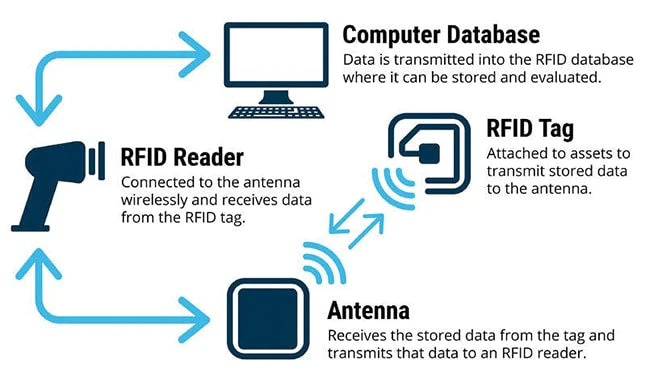
In a world where technology continually pushes boundaries and transforms the way we interact with the world around us, Near Field Communication (NFC) and Radio-Frequency Identification (RFID) are two remarkable technologies that have gained prominence. From the convenience of contactless payments to the security of government-issued RFIDs, these technologies have seamlessly integrated into our daily lives. In this blog, we will delve into how RFID works, exploring its various forms, applications, and the role of smartphones in this technology revolution.
RFID is an incredible application of technology for accuracy, efficiency, and security in the supply chain. RFID provides a unique identifier on materials or goods that can be read almost instantaneously, providing systems with information for automation and decision-making.
In order to maximize those benefits, it is important to properly configure and tune RFID readers for the operating environment. In this article, I will provide guidance on an RFID solution, from tag selection to antenna placement and everything in between. How the technology is applied is nearly limitless, especially when paired with AI or custom software.
First, let’s start with a quick refresher on how RFID works…

Transform your supply chain with RFID technology – Contact Bluefletch today!
An RFID reader sends Radio Frequency (RF) signals via an antenna. The antenna radiates the RF energy, and it is absorbed by the RFID tag attached to a good or material. The tag uses the absorbed energy to “power up” and return data from the embedded chip. The returned RF signal is captured by the reader’s antenna and decoded by the reader. A connected system receives the decoded input for decision making.
Benefits
Compared to traditional barcode scanning for inventory control, RFID provides huge labor savings. Instead of a worker finding and scanning a barcode, RFID does not require direct line-of-sight. A fixed or mounted reader can capture all tags over a large area in a fraction of the time when compared to traditional 1D/2D laser scanners. With RFID components working in harmony, true inventory accuracy can be achieved in a fraction of the time a traditional cycle count requires.
Beyond labor savings and accuracy, additional security and theft mitigation is made possible with RFID. A great use case in retail is preventing theft and loss of goods by placing readers at the entry/exit and ensuring all items passing through have been paid for. In a warehouse, this same concept of increased visibility can be applied to ensure tools and equipment never leave the work area.
There are four main components required for an RFID scan transaction: a reader, an antenna, an RFID tag, and a system for processing the result(s).
The Essence of RFID
At its core, RFID is a wireless communication technology that relies on electromagnetic fields to transmit data between a reader (or scanner) and a tag (or label). The key differentiator in RFID technology lies in the various types of tags, each with its unique characteristics and applications. These tags can be broadly categorized into three types: Active, Semi-passive, and Passive RFID tags.
Reader and Antenna:
Readers both transmit and receive RFID via the antenna. The hardware is compact enough to embed in handheld units, which are widely popular in retail for picking and order fulfillment. The captured scans are processed by the connected mobile computer. Similar to a metal detector, a Geiger counter feature can inform the picker if they are getting closer or further away from the desired object.
Larger, fixed readers generally have more power for longer read ranges and are perfect for defined areas like assembly lines, scanning all passing items, and providing real-time information about their location. Just remember, you need enough power to return an RF signal as well!
Active RFID Tags:
Active RFID tags are the powerhouse of the RFID family. Unlike their passive counterparts, active tags have their own power source (usually a battery) that enables them to transmit data over relatively long distances, sometimes up to several hundred meters. These tags are commonly used in tracking high-value assets, monitoring supply chains, and managing inventory in large warehouses.
RFID Tags:
Active RFID uses a battery-powered RFID tag to periodically transmit signal whereas passive RFID tags consist of just an antenna and chip which is temporarily powered by energy from a reader. Passive tags contain no battery and therefore are exponentially cheaper and smaller than active tags, which is why passive tags are used for item-level tagging in the supply chain. Active tags can provide a much longer read range since they don’t rely on the absorbed energy, but their price limits their suitability to high-value assets only.
Within the options of Passive tags, there are also different operating frequencies. Ultra Highfrequency UHF tags are the least expensive and are the de facto standard for supply chain and item-level tracking, with a read range of up to 20 meters. However, the higher the frequency, the more prone to interference by liquids and metals due to the shorter energy wavelength. If your operating environment is among large amounts of liquid or metal then read range and accuracy will be negatively affected.
Semi-passive RFID Tags:
Semi-passive RFID tags, as the name suggests, fall in between the active and passive tags. They have a built-in battery to power their onboard circuitry, which enhances their performance compared to passive tags. These tags are often used in applications where a longer read range is required, such as in toll collection systems and monitoring temperature-sensitive goods during transport.
Passive RFID Tags:
Passive RFID tags are the simplest and most widely used among the three types. They don’t have their own power source; instead, they rely on the electromagnetic field generated by the RFID reader to power their circuits momentarily when they’re within proximity. This energy harvesting method allows passive tags to transmit their stored data back to the reader. These tags are commonly seen in access control systems, inventory management, and even in the tags used for tracking pets.
Smartphones and RFID:
One of the most significant developments in recent years is the integration of RFID technology with smartphones. Many modern smartphones are equipped with NFC capabilities, which stands for Near Field Communication. NFC is a subset of RFID technology that operates in the high-frequency range and typically has a short read range, typically a few centimeters. This makes NFC ideal for applications requiring close proximity, like mobile payments and sharing information between devices.
Smartphones with NFC can serve as both RFID readers and tags. They can communicate with various NFC-enabled objects, such as smart cards, posters, or even other smartphones. NFC has revolutionized the way we make payments, access public transportation, and share information. The convenience of simply tapping your phone to make a purchase or exchange contact information has become a ubiquitous part of our daily lives.
Government-issued RFID'S:
Beyond the convenience of NFC-enabled smartphones, RFID technology plays a crucial role in security and identification, especially when it comes to government-issued RFIDs. Governments worldwide have adopted RFID technology to enhance security measures, streamline processes, and improve citizen services.
For instance, e-passports utilize RFID technology to store biometric data and travel information securely. This not only speeds up immigration processes but also enhances border security. In addition, some national IDs and driver’s licenses now come equipped with RFID chips to prevent counterfeiting and provide quick access to essential information when needed.
Unlock the power of RFID in your business – Schedule a consultation now!
Connected System:
Captured data must be processed to extract any business value. A connected computer leveraging AI to automate actions based on an RFID input is a great model for many logistics companies. When creating software, the possibilities are nearly endless depending on what you need to do with the unique tag data.

Building a Simple Shopping List for an RFID PoC
We love running proof of concepts at BlueFletch and our lab has run RFID tests to prove the viability of the technology and test additional complementary technologies. We’d love to partner with you on your RFID project but if you are looking to run your own POC, first obtain the required components for an RFID scan transaction:
Tags
In the last few years, RFID tags have become very cheap, in bulk prices can be under 5 cents apiece. When deciding on a passive UHF RFID tag, the biggest consideration is the tag size. The larger the tag, the larger the embedded antenna and the longer the read range. For lab testing, we purchased and demoed the Zebra’s 4×6 label for $25.
Reader and Antenna
As mentioned previously, RFID readers can be contained within a handheld unit. The most versatile of which is the Zebra RFD8500. This unit can pair to both Android and iOS devices, and scan traditional 1D/2D barcodes with the integrated laser. The unit itself is quite pricey at roughly $1,500 but the versatility has allowed us to demo multiple configurations on multiple device types.

Connected System
There are free apps for your mobile device to connect to an RFID reader if you want to test a simple scan and retrieve functionality. At BlueFletch we have developed custom range finding and picking Android applications for testing. If you need any assistance in developing a POC software solution, please reach out!
Final Takeaways
In conclusion, RFID technology, with its Active, Semi-passive, and Passive RFID Tags, has transformed the way we interact with our world. From the convenience of using NFC-enabled smartphones for payments and sharing information to the enhanced security and efficiency offered by government-issued RFIDs, the impact of RFID is profound and ever-expanding. As technology continues to evolve, we can only imagine the exciting possibilities that await us in the realm of RFID and NFC. These innovations are sure to continue reshaping the way we live and work in the digital age. Maximize efficiency with RFID solutions – Let Bluefletch show you how!
At BlueFletch, we are excited by combining new technologies and finding creative solutions for complex problems. There are many possibilities with RFID, and we’ve just scratched the surface with this post. Each RFID solution is going to be affected by numerous factors and thus must be tested and tuned in the operating environment. There is no bulletproof solution and as MIT research has stated it is “not possible to model the wireless channel in a site accurately.”
In the meantime, I would love to continue experimenting with RFID and run another POC to prove one of these solutions:
- Test different antenna types to create a defined area for reading, such as a parts bin that reads sorted tags when they are placed in the bin.
- Test a panel antenna for setting a zone of coverage, such as warehouse bay that someone might walk across.
- Further refine an algorithm to estimate the distance from RFID tag based on RSSI. It should be noted that RSSI is not intended to determine distance and is very prone to interference.
- Attach a reader to a robot that “walks” the aisles/bays each evening when the site is empty for an automated cycle count.
What sort of RFID initiatives are you looking to prove out? Shoot us an email at info@bluefletch.com, we’d love to hear about them!
